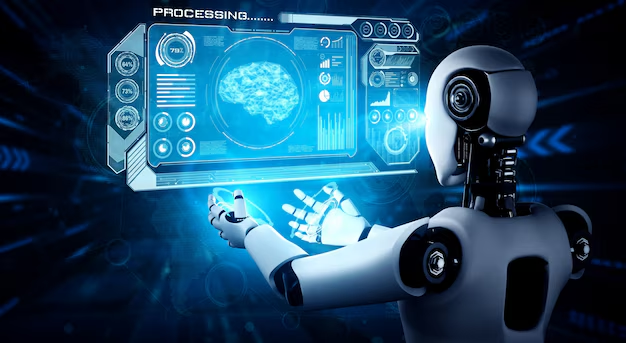The rapid advancement of machine learning and robotics is reshaping industries, revolutionizing workflows, and enhancing efficiency across various sectors. From manufacturing and healthcare to logistics and customer service, automation powered by AI-driven robotics is paving the way for a smarter, more autonomous future. This article explores the role of machine learning in robotics and how it is driving the next wave of automation.
1. The Role of Machine Learning in Robotics

Machine learning (ML) is at the core of modern robotics, enabling machines to:
- Learn from experience and improve their performance over time.
- Recognize patterns in vast amounts of data to make intelligent decisions.
- Adapt to dynamic environments without the need for explicit programming.
- Enhance perception and control through computer vision and deep learning.
2. Applications of Machine Learning in Robotics
The integration of ML in robotics has led to breakthroughs in various fields, including:
A. Industrial Automation
- Robotics in manufacturing enhances precision, reduces errors, and increases productivity.
- Machine learning enables predictive maintenance, reducing downtime and operational costs.
- AI-powered robotic arms streamline assembly lines, ensuring consistent quality.
B. Healthcare and Medical Robotics
- AI-driven robotic assistants assist surgeons in performing complex, minimally invasive procedures.
- Machine learning improves diagnostics by analyzing medical images with high accuracy.
- Robotic prosthetics and exoskeletons provide mobility solutions for disabled individuals.
C. Autonomous Vehicles and Drones
- Self-driving cars use ML algorithms to interpret sensor data, navigate roads, and make split-second decisions.
- Drones powered by AI perform aerial mapping, surveillance, and package deliveries efficiently.
- ML enhances collision avoidance and route optimization for autonomous mobility.
D. Logistics and Warehouse Automation
- AI-powered robots streamline order fulfillment, picking, and packing in warehouses.
- Machine learning enhances inventory management and demand forecasting.
- Autonomous robots collaborate with human workers to improve operational efficiency.
E. Agriculture and Smart Farming
- Robotic harvesters equipped with AI detect ripe crops and perform precision farming.
- Drones monitor soil health, irrigation needs, and pest infestations using ML analysis.
- AI-driven automation reduces resource waste and boosts agricultural productivity.
F. Customer Service and AI Assistants
- AI-powered chatbots and virtual assistants provide instant, automated customer support.
- Service robots assist in hotels, retail stores, and airports to improve customer experience.
- ML-based recommendation engines personalize user experiences across industries.
3. Benefits of Machine Learning in Robotics

Machine learning and robotics offer numerous advantages, including:
- Improved Accuracy: AI-driven robots reduce human errors in critical tasks.
- Increased Productivity: Automation accelerates workflows and enhances efficiency.
- Cost Savings: Reducing human intervention lowers labor costs and operational expenses.
- Scalability: AI-powered systems can handle large-scale tasks with minimal oversight.
- Innovation: Robotics and AI drive innovation, creating new business opportunities and jobs.
4. Challenges and Ethical Considerations
Despite its potential, the integration of machine learning and robotics comes with challenges:
- Job Displacement: Increased automation may replace traditional roles, requiring workforce reskilling.
- Bias and Fairness: ML algorithms must be designed to avoid biases in decision-making.
- Security Concerns: AI-driven robots are susceptible to cyber threats and data breaches.
- High Initial Costs: Implementing AI and robotics requires significant investment in infrastructure.
- Regulatory and Legal Issues: Governments must establish guidelines for AI-driven automation.
5. The Future of Machine Learning and Robotics

The future of AI-driven robotics will focus on:
- Collaborative Robots (Cobots): AI-powered robots working alongside humans to enhance efficiency.
- Advanced AI Reasoning: Robots with better decision-making capabilities and real-time learning.
- Human-AI Interaction: Improved natural language processing for seamless communication.
- AI-Driven Creativity: Robots capable of assisting in creative tasks like art and music.
- Smart Cities and Automation: AI and robotics optimizing urban infrastructure and public services.
Also Read : AI in Education: Transforming Learning and Teaching Methods
Conclusion
Machine learning and robotics are shaping the future of automation by enhancing efficiency, precision, and adaptability across industries. While challenges such as job displacement and ethical concerns remain, the benefits of AI-driven robotics outweigh the risks. As technology continues to advance, businesses and individuals must embrace these innovations to stay competitive in an increasingly automated world.
FAQs
1. What is the difference between robotics and AI?
Robotics involves designing and building machines that can perform tasks, while AI enables these machines to think, learn, and make decisions autonomously.
2. How does machine learning improve robotic automation?
Machine learning helps robots adapt, recognize patterns, and improve performance based on data analysis and experience.
3. Will robots replace human workers in the future?
While some jobs may be automated, new opportunities will arise, requiring human oversight, creativity, and technical expertise.
4. What industries benefit the most from AI-driven robotics?
Industries such as manufacturing, healthcare, logistics, agriculture, and customer service benefit significantly from AI-powered robotics.
5. What are collaborative robots (cobots)?
Cobots are AI-powered robots designed to work alongside humans, enhancing productivity without replacing human roles.

